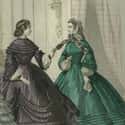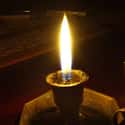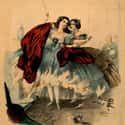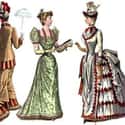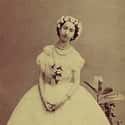Random Women's Dresses Used To Be Flammable Death Traps, Killing 3,000 Ladies In One Year (11 items)
-
(#4) Women Actually Wore Arsenic
The danger of a Victorian dress was compounded by the fact that it was often dyed with dangerous chemicals, most especially arsenic. Green was a particularly fashionable color in the Victorian era, and a good way to get that shade was with arsenic dye. Hats, gloves, and yes, even dresses, were colored green with the chemical; without even catching on fire, some women died horrible deaths as a result.
In 1861, a 19-year-old artificial flower maker named Matilda Scheurer was felled by the simple act of working with the dye. She convulsed and vomited, then foamed at the mouth in a harsh shade of green. It was later discovered that there was arsenic in her liver, lungs, and stomach. The level was so high that even the whites of her eyes were tinged green.
While arsenic-laced dresses were dangerous enough, the flammability factor only made things worse. Burning an arsenic dress could release toxic fumes into the air which, of course, the woman wearing the dress would inhale. Even if she wasn't killed immediately by the flames, just breathing the smoke could cause serious health problems and lead to her early demise.
-
(#8) A Lack Of Electricity Made Every Room A Potential Hazard
Completely separate from the shape and material of the dresses, the very nature of daily life in the 1800's put people at risk. Electricity only began to catch on towards the end of the century, so lighting in homes was mostly left to natural lighting, candles, and gas. The average home, both in the UK and in the United States, relied on oil lamps and fireplaces for light and warmth, both of which had dangerous open flames.
Since many buildings were made out of highly flammable materials, and fireproofing was essentially nonexistent, women could burn down entire houses when their dresses caught fire.
-
(#5) The Shape Of The Dresses Made Them Even Deadlier
Besides the materials, the very shape of the dresses themselves were a huge hazard. Crinolines – stiffened, cage-like petticoats – were very popular in the mid-1800's. These petticoats held out skirts in bell-like shapes without adding extra weight; this allowed women to feel lighter and move more easily, but it also made their dresses far more flammable.
The full skirt with a pocket of air beneath would act like a cone or funnel, and when it caught fire the woman's body would be held in the center without escape. Couple the shape with the layers of light fabric draped over it, and you're left with the perfect recipe for a whole lower half of a dress to be engulfed in moments.
As an odd side note, this shape actually did have a few benefits. On more than one occasion, a crinoline dress reportedly acted as a buoy and saved women from drowning. A few others were even saved from suicide attempts as their gown slowed their fall from heights. Still, none of this was nearly enough to offset all the deaths they caused.
-
(#11) Changing Fashion Trends Actually Made Clothing Safer
You might think that, with all these deaths, changes would be made to clothing in order to protect women. A few places of work did step up to ban the dangerous dresses, including a textile company that reportedly restricted crinoline usage in 1898 after the death of a worker at a firewood factory. But such rules had less impact than the tide of fashion – it simply changed, and different shapes came into vogue.
Arsenic dyes were eventually phased out; flammable fabric was still generally used, but at least the shapes of dresses began to change. In the 1870s, bustles became the new fad, meaning the bulk of the dress was in the back while the front remained relatively slim. This drastically reduced the possibility of a skirt becoming a flaming cone of fire. By the 1890s, skirts had become even slimmer, meaning that women could move around their homes without being at such a constant high risk of catching flame.
Fashion aside, the large-scale implementation of electricity helped reduce prevalence of open flames within the home, further cutting down on deadly incidents.
-
(#6) Even Archduchesses Weren't Safe From Death By Dress
There were no social divides when it came to dying by burning garments. In 1861, Henry Wadsworth Longfellow's wife, Fanny, died when her dress caught on fire; she perished in front of her own children. In 1871, Mary and Emily Wilde, the half-sisters of Oscar Wilde, met a similar fate at a Halloween party. One of the women was dancing when her dress caught fire, and her sister rushed to help her. However, the fire just spread, and both women burned to death.
An influential woman in her own right, Archduchess Mathilde of Austria, also met a fiery end. She was smoking a cigarette when her father, who had forbidden them in his presence, approached her to talk. She hid the cigarette behind her back, which then set her dress aflame. The gown was gauze, and very flammable, and her whole body went up in an instant. She died at only 18.
-
(#3) Ballerinas Were Particularly Susceptible To Fiery Doom
Even for those who didn't wear the enormous crinoline hoop skirts that were popular in the Victorian era, death by flaming dress was still a very real possibility. Ballerinas in particular were in constant danger of being burned alive. For one thing, their dresses were made of terribly flammable material, such as bobbinet, cotton muslin, gauze, and tarlatan. All of these made the ballerinas seem light, ethereal, and delicate when they moved, and made their skirts stand out in the traditional style. However, these fabrics were also prone to light up in a heartbeat when exposed to the open flames often used in stage lighting, and they did so with shocking regularity.
In 1862, a popular ballerina named Emma Livry was running through a dress rehearsal for an opera when tragedy struck. Her skirt got too close to a gaslight, and her costume was lit ablaze. She was consumed by flames before someone was at last able to put her out. Livry was given immediate medical care, and managed to survive for eight months, but ultimately died of blood poisoning related to her burns.
Livry was hardly the only dancer to succumb to such a fate; in 1844, a dancer named Clara Webster met the same end. In 1861, six dancers died when they tried to help a fellow ballerina who caught fire backstage. It was not unheard of for entire ballet troupes or theaters to go up in flame.
New Random Displays Display All By Ranking
About This Tool
Boning corsets and crinoline petticoats were very popular in the Victorian era, but these dresses were tight enough to make people faint. These oversized petticoats had very exaggerated perimeters and wide flouncing. They were so large that they could even protect women from drowning. Although hoop petticoats were a symbol of fashion at that time, they were very dangerous. , Because this material is very flammable.
During the 1850s, the fluffy and wide skirts were made of multiple layers of skirts, once it is accidentally ignited, the flame will spread quickly in the fabric. More than 3,000 people died from the skirts. The random tool introduced 11 details about these beautiful but dangerous women's dresses.
Our data comes from Ranker, If you want to participate in the ranking of items displayed on this page, please click here.

